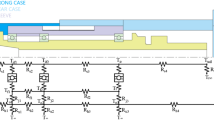Abstract
Thermal error is one of the main errors in ultra-precision machine tools. This paper presents a thermodynamics-based structure optimization method to reduce the thermal displacements of machine tools during operation. The method makes use of the thermal–structure coupled model to analyze the thermal behavior considering the thermal contact resistance and the temperature rise of the oil film in hydrostatic spindle. The structure of the motor link, spindle, and headstock of grinder are optimized by setting appropriate gaps in the contact region of two neighboring parts to change the heat transfer distribution and minimize the thermal displacement of the spindle center position. The proposed method is validated by an equivalent thermal conductivity-based simulation method and experiment on an ultra-precision grinding machine tool. Experimental results show that the proposed method can provide an important instruction on how to reduce the thermal error for the design of the precision machine tools, especially for those with key parts placed near the heat sources.
Similar content being viewed by others
References
Han J, Wang L, Wang H, Cheng N (2012) A new thermal error modeling method for CNC machine tools. Int J Adv Manuf Technol 62(1-4):205–212
Mayr J, Jedrzejewski J, Uhlmann E, Donmez MA, Knapp W, Härtig F, Wendt K, Moriwaki T, Shore P, Schmitt R, Brecher C, Würz T, Wegener K (2012) Thermal issues in machine tools. Ann CIRP 61(2):771–791
Liang RJ, Ye WH, Zhang HH, Yang QF (2012) The thermal error optimization models for CNC machine tools. Int J Adv Manuf Technol 63(9):1167–1176
Ramesh R, Mannan MA, Poo AN (2000) Error compensation in machine tools-a review: part II: thermal errors. Int J Mach Tool Manuf 40(9):1257–1284
Bryan J (1990) International status of thermal error research. Ann CIRP 39(2):645–656
Liang Y, Su H, Lu L, Chen W, Sun Y, Zhang P (2015) Thermal optimization of an ultra-precision machine tool by the thermal displacement decomposition and counteraction method. Int J Mach Tool Manuf 76(1-4):635–645
Chen TY, Wei WJ, Tsai JC (1999) Optimum design of headstocks of precision lathes. Int J Mach Tool Manuf 39(12):1961–1977
Mori M, Mizuguchi H, Fujishima M, Idoa Y, Mingkaib N, Konishib K (2009) Design optimization and development of CNC lathe headstock to minimize thermal deformation. Ann CIRP 58(1):331–334
Zhang JF, Feng PF, Chen C, Yu DW, Wu ZJ (2013) A method for thermal performance modelling and simulation of machine tools. Int J Adv Manuf Technol 68(5-8):1517–1527
Abdou G, Tereshkovich W (2000) Performance evaluation of a permanent magnet brushless DC linear drive for high-speed machining using finite element analysis. Finite Elem Anal Des 35(2):169–188
Chayopitak N, Taylor DG (2005) Thermal analysis of linear variable reluctance motor for manufacturing automation applications. Proceedings of of the IEEE. International Electric Machines and Drives Conference, San Antonio, Texas, pp 866–873
Jang C, Kim JY, Kim YJ, Kim JO (2003) Heat transfer analysis and simplified thermal resistance modeling of linear motor driven stages for SMT applications. IEEE T Compon Pack T 26(3):532–540
Chow JH, Zhong ZW, Lin W, Khoo LP (2012) A study of thermal deformation in the carriage of a permanent magnet direct drive linear motor stage. Appl Therm Eng 48(15):89–96
Kim JJ, Jeong YH, Cho DW (2004) Thermal behaviour of a machine tool equipped with linear motors. Int J Mach Tool Manuf 44(7):749–758
Yin YH, Nee AYC, Ong K, Zhu JY, Gu PH, Chen LJ (2015) Automating design with intelligent human-machine integration. Ann CIRP 64(2):655–677
Ma C, Mei XS, Yang J, Zhao L, Shi H (2015) Thermal characteristics analysis and experimental study on the high-speed spindle system. Int J Adv Manuf Tech 79(1):469–489
Kurpisz K, Nowak AJ (1995) Inverse thermal problems. WIT Press, UK
Chen DJ, Bonis M, Zhang FH, Dong S (2011) Thermal error of a hydrostatic spindle. Precis Eng 35(3):512–520
Zheng EL, Jia F, Zhu SH (2014) Thermal modelling and characteristics analysis of High speed press system. Int J Mach Tool Manuf 85(1):87–99
Calmidi VV, Mahajan RL (1999) The effective thermal conductivity of high porosity fibrous metal foams. J Heat Transfer 121(2):466–471
Author information
Authors and Affiliations
Corresponding author
Rights and permissions
About this article
Cite this article
Sun, L., Ren, M., Hong, H. et al. Thermal error reduction based on thermodynamics structure optimization method for an ultra-precision machine tool. Int J Adv Manuf Technol 88, 1267–1277 (2017). https://doi.org/10.1007/s00170-016-8868-x
Received:
Accepted:
Published:
Issue Date:
DOI: https://doi.org/10.1007/s00170-016-8868-x



